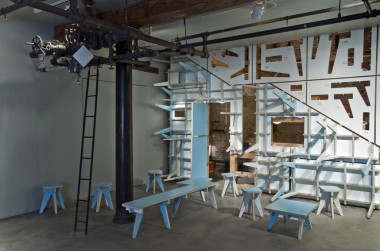interview with Renny Ramakers

Wall of furniture parts by Studio Makking & Bey (2008), Droog New York
Why did you embark a project on downloadable design?
Renny Ramakers: In 2008 we were working on the interior of Droog New York. The store featured Wall of furniture parts by Studio Makkink & Bey—a wall next to the stairs made of CNC cut furniture parts that can be taken out of the wall as needed for use. It turned out that the idea in principle was strong, but the design was not optimized for downloading. We wanted to explore in more detail the possibilities of developing products that can be downloaded as a file and an online distribution platform to enable this.
What were some of your findings?
RR: Three main aspects make this platform unique.
It will have a curated sphere next to an open sphere. The curated aspect is very important as we anticipate that the open sphere will give rise to a lot of low quality content.
Another important decision was to incorporate both digital producers and ordinary workshops in the network of manufacturers. I like the idea that through a digital network one can enhance crafts. In bridging high- and low-tech it becomes similar to our Dry tech projects. Our goal is to create a network of certified producers, and in some cases the files will go directly to the producers and the consumer will receive the finished good.
And, the platform will feature not only furniture and products but also food, architecture, inventions and fashion.
It’s important to note that this platform will not be a Droog platform. We will invite other companies and institutions to have their own curated stores on the platform and they can create their own business models on it. Droog will be one of the curated stores on the platform.
How did you work with the designers for Droog’s presence on the platform?
RR: We invited a team of designers to develop designs specifically for downloads. We also encouraged the designers to create a business model for themselves. Should the downloads be for free or should they cost something? Perhaps the designs ask for additional services? These were all considerations for designers.
For some of the products, software has been developed for downloaders to be able to customize the design. These design tools give users the possibility to change the design from a functional perspective. Customization goes further than just picking from a standard set of colours or materials. The interface also makes it possible for ordinary computer users to change the design. User involvement has always been important for Droog.
